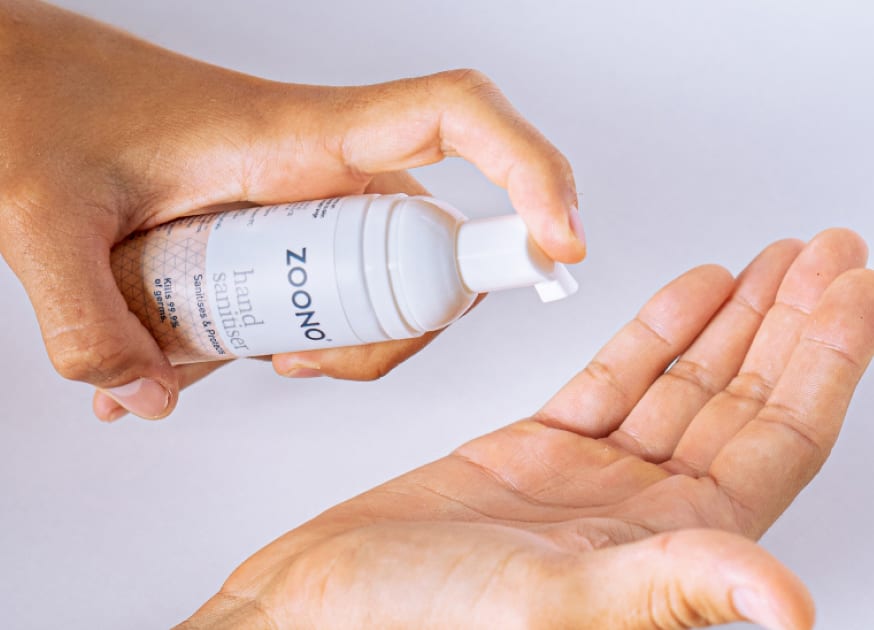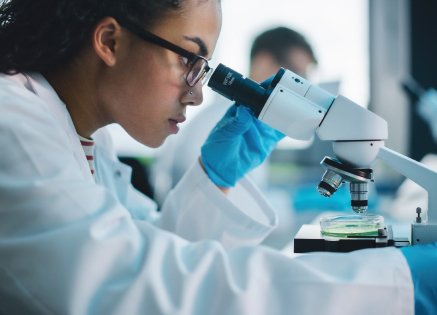15/02/2021 | jade pallett
As we try to limit the transmission of bacteria and microbes to contain the spread of diseases, what are surfaces we should pay particular attention to and how does the use of antimicrobial coatings outdo traditional modes of disinfection?
A variety of pathogens have shown capabilities to survive for prolonged periods within the environment. One of the most researched areas for surface transmission of pathogens is within the healthcare environment.1 The microbiota of human skin, particularly from the hands, is a known source of surface contamination with particular emphasis on high-touch surfaces.2
The potential for surfaces that have microbes deposited on them to contribute to the overall transmission of pathogens is dependent on a variety of factors.8 As a general rule, microbes prefer to grow and replicate in environments that are moist and contain organic material. Despite this, many pathogens are known to be able to persist under dry conditions.10 Assessing the contribution of microbes in the cause of infection can be particularly difficult, especially when discussing the contamination of surfaces in the wider environment.
Many areas in the wider public environment can be considered high-touch surfaces. Examples of these areas would include bin handles, business door handles, communal toilets, road crossing buttons, and public transport.11 Data detailing the prevalence of pathogens on high-touch surfaces within community settings is limited when compared with the data available from healthcare settings. Contamination of these areas with microbes is widely accepted, however, steps being taken to mitigate this risk outside of the response to the pandemic has been somewhat limited.
Whilst the pandemic has been a catalyst in many areas for a heightened cleaning protocol, the risk of microbial transmission within public spaces was known long before. One potential solution to reducing the rate of contamination and transmission in the community setting would be the use of antimicrobial coatings. The use of antimicrobial coatings can help to lower the risk of contamination between cleaning opportunities. Where standard disinfection protocols can effectively remove contamination at the point of application, their antimicrobial activity is generally short-lived and the surface becomes open to contamination once more. This is particularly prevalent with high-touch surfaces within community settings where there is a high concentration of people.
Commonly Transmitted Microbes
Much research has been conducted within the healthcare environment to determine the pathogens that have the highest capability to survive on surfaces and within the environment. Key pathogens include methicillin-resistant Staphylococcus aureus (MRSA), Clostridium difficile, vancomycin-resistant Enterococcus (VRE), Pseudomonas aeruginosa, Acinetobacter baumannii, norovirus, coronavirus, and Candida species, with VRE having a particular capability for survival in dry environments for long periods.3,4,5,6,7
Fewer studies have been conducted within the wider environment to determine the prevalence of microbes on surfaces and high-touch surfaces. One area of focus has been public transport, especially in cities, where there is high and frequent footfall. High levels of hand-to-surface contact often result in a high level of Staphylococcus species being present on surfaces.
A study conducted in a mid-sized US city analysed the incidence of Staphylococcus on a public transport system. It found a variable level of resistance amongst the 11 isolated species of Staphylococcus, with five of the strains found to be resistant to both penicillin and ampicillin.12 High-touch surfaces have been shown to be contaminated with Staphylococcus and other bacterial species. These surfaces may act as a reservoir for clinically important bacterial species such as community-associated MRSA or multidrug-resistant E. coli.13 Public toilets are recognised as high-touch surfaces, with a study finding 21 per cent of samples sites containing Coliform bacteria, which is an indicator of faecal contamination.17
One study that investigated the prevalence of SARS-CoV-2 on high-touch surfaces in a town in Massachusetts found 8.3 per cent (29/348) of surfaces to be positive for RNA during April – June 2020.10 This is a slightly higher incidence than a study conducted in a densely populated area in Brazil, which found an incidence rate for SARS-CoV-2 RNA to be around 5.3 per cent (49/933 samples).11 Whilst there is still much research needed to be conducted in order to define the role of surface transmission in infection, there is preliminary evidence that surface contamination is widespread and could contribute to the spread of disease.
Of the literature available, it has been shown on numerous occasions that high-touch surfaces in public areas can act as reservoirs for a host of microbes, including potentially antimicrobial resistance strains. A range of different pathogens including both Gram-positive and Gram-negative bacteria, as well as viruses, have been identified in high-touch surfaces in community settings.
Areas of High Transmission
There is a high risk of transmission in the wider environment where common interactions take place, such as public transport, shared working environments, or communal toilets. Environmental surveillance has been described as an underutilised tool in the understanding of transmission.10 High-touch surfaces in the community setting are thought to be a possible reservoir for multidrug-resistant pathogens.14 A study conducted in Chengdu, China, researched the prevalence of antimicrobial resistance genes on shared bicycles in the area.15 It was found that the dock-less bicycles may be acting as a reservoir in the transmission of antimicrobial resistance genes, specifically in Enterococci and Staphylococci, alongside accelerating the dissemination of these pathogens.
Reports analysing high-touch surfaces in public transport systems have shown the survival of a wide range of pathogens on multiple types of materials.12 Commonly, the microbes present on these surfaces are a result of the microbes that are present on the skin, both within the normal flora and contamination from other sources e.g. coughing or sneezing into your hands. The prevalence of infection in humans is known to fluctuate seasonally, regionally, and with age. This results in the levels of pathogens excreted by humans being largely variable.16 Although people are one of the major sources of microbes, environmental surfaces found to contribute to the harbouring and transmission of microbes include:
Dry surfaces (e.g. countertops, handles, rails, shared equipment, and tables)
Wet surfaces (moist environments e.g. cooling towers, floors, sinks, and taps)
Dust or decaying debris (e.g. materials from construction activity, leaks, or spillages)
Transmission from these surfaces occurs by contact with these contaminated surfaces by touch, which can then be ingested by a person or passed on to another surface.19 There is a research gap identified where further investigation needs to be conducted to find out the incidence of infection/disease resulting from transmission via high-touch surfaces and fomites within public spaces.
Types of Surface
The role of environmental surfaces in the epidemiology of hospital-acquired infections has become a significant area of interest within the scientific community. A focus on research within the healthcare industry is due to the publicised cases of methicillin-resistant Staphylococcus aureus and Clostridium difficile within hospitals.20 The role of environmental surfaces in community settings in the epidemiology of infections is a largely unresearched topic. Some light has been shed on this previously, with particular focus on clinically relevant species such as MRSA and multidrug-resistant pathogens. The pandemic has additionally resulted in novel research surrounding the incidence and potential spread of SARS-CoV-2 within the community setting, however, investigations into other viruses in the community setting are limited. Despite this, the research into the survivability of SARS-CoV-2 on a range of different surfaces has provided useful insight into the variability between survival on different materials.21
One study that was conducted within public transport systems in the city of Portland, Oregon, analysed the prevalence of Staphylococcus species. The study found the highest incidence of contamination was on the floors and cloth seats.12 The findings of a review into the safety of the public transportation system from a health perspective found the choice of materials to be of significant influence to minimise exposure to potentially harmful microbes.18 Textiles and fabrics have been found to have the ability to harbour pathogens for longer than some other surfaces. For example, certain fabrics used in upholstery have been found to harbour vancomycin-resistant Enterococci for at least seven days after simulated contamination.22
There are many factors that influence the ability of microbes to survive upon a given surface. A major factor that should be considered is the surface topography of materials. The type of substrate used for surfaces, floors and walls, and the use of certain textile fibres can all influence the survivability of microbes on a given surface.22 The surface topography of different materials can change the adhesion, colonisation, and tenacity of microbes, which in turn can influence onward transmission.23
Surface topography can also heavily influence the ability of pathogens in biofilm formation. Biofilms are multi-cellular communities that hold together by producing an extracellular matrix; they are typically resistant to normal disinfection protocols.25 Biofilms tend to form in little holes within porous/textile surfaces. This results in the biofilm being hard to reach and increasing the microbial tenacity, improving chances of onwards transmission.24 Biofilms are also able to form within small scratches or damaged areas of normally non-porous materials (e.g. scratched stainless steel). It has been suggested that biofilm formation enables survival advantages by increasing the ability of the pathogen to persist in a diverse range of environmental conditions.26
Role of Antimicrobial Coatings
In order to enhance the level of cleanliness and improve infection prevention and control within the wider environment, the utilisation of an antimicrobial coating should be strongly considered. The limitations of traditional cleaning have been long understood, with the efficacy of products being limited to the point of cleaning. Once the cleaning has occurred, that surface is then able to be contaminated once more. Onwards transmission from contaminated surfaces leads to the possibility of infection further down the line.
The use of an antimicrobial coating, which protects against microbes between cleaning by leaving a residual coating on the surface that can continue to inactivate microbes, can help to mitigate the risk of cross-contamination and transmission. Levels of surface bioburden have been documented to remain reduced with the use of continuously antimicrobial surface coatings.27 Some of the chemical technologies used in existing antimicrobial coatings include: silver ions (an active eluting agent), TiO2 (a light-activated molecule), and quaternary ammonium polymers (immobilised molecules that become effective upon interaction) such as Zoono Z-71 Microbe Shield. Non-leaching antimicrobial technologies, such as Zoono, are becoming more prevalent, providing an enhanced level of protection between standard cleaning practices, remaining active on the surface for multi-touch protection. The widespread development and use of antimicrobial coatings are of great importance in maintaining acceptable levels of hygiene both in the healthcare environment and also within high-touch surfaces in the wider community.
Conclusion
Overall, whilst there is still much to be learnt about the exact role of surfaces in the transmission of microbes in the community setting, there is compelling evidence to suggest microbial contamination of surfaces is an area for concern. The spread of diseases outside of the healthcare environment suggests there is potential for surface contamination to play a role within transmissions. Whilst the careful selection of substrates at the manufacturing stage may be of use in reducing surface contamination, this is not an easily employed solution to all the pre-existing surfaces within the community.
One technology that could be considered to be incorporated into infection prevention and control strategies moving forward would be the use of antimicrobial coatings. Such coatings would offer an additional layer of protection between routine disinfection opportunities and have shown promising results on other high-touch surfaces for reducing overall surface contamination. Reducing levels of clinically important microbes on environmental surfaces within the community would be expected to result in a reduction in the transmission of potentially harmful microbes within the community.
References
Weinstein, R.A., 1991. Epidemiology and control of nosocomial infections in adult intensive care units. The American journal of medicine, 91(3), pp.S179-S184.
Weber, D.J., Anderson, D. and Rutala, W.A., 2013. The role of the surface environment in healthcare-associated infections. Current opinion in infectious diseases, 26(4), pp.338-344.
Dancer SJ. Importance of the environment in meticillin-resistant Staphylococcus aureus acquisition: the case for hospital cleaning. The Lancet infectious diseases. 2008 Feb 1;8(2):101-13.
Martínez, J.A., Ruthazer, R., Hansjosten, K., Barefoot, L. and Snydman, D.R., 2003. Role of environmental contamination as a risk factor for acquisition of vancomycin-resistant enterococci in patients treated in a medical intensive care unit. Archives of internal medicine, 163(16), pp.1905-1912.
Tankovic, J., Legrand, P., De Gatines, G.E.O.F.F.R.O.Y., Chemineau, V., Brun-Buisson, C. and Duval, J., 1994. Characterization of a hospital outbreak of imipenem-resistant Acinetobacter baumannii by phenotypic and genotypic typing methods. Journal of Clinical Microbiology, 32(11), pp.2677-2681.
Green, J., Wright, P.A., Gallimore, C.I., Mitchell, O., Morgan-Capner, P. and Brown, D.W.G., 1998. The role of environmental contamination with small round structured viruses in a hospital outbreak investigated by reverse-transcriptase polymerase chain reaction assay. Journal of Hospital Infection, 39(1), pp.39-45.
Kaatz, G.W., Gitlin, S.D., Schaberg, D.R., Wilson, K.H., KAUFFMAN, C.A., Seo, S.M. and Fekety, R., 1988. Acquisition of Clostridium difficile from the hospital environment. American journal of epidemiology, 127(6), pp.1289-1294.
Boyce, J.M., 2007. Environmental contamination makes an important contribution to hospital infection. Journal of hospital infection, 65, pp.50-54.
Mirhoseini, S.H., Nikaeen, M., Shamsizadeh, Z. and Khanahmad, H., 2016. Hospital air: A potential route for transmission of infections caused by β-lactam–resistant bacteria. American journal of infection control, 44(8), pp.898-904.
Harvey, A.P., Fuhrmeister, E.R., Cantrell, M.E., Pitol, A.K., Swarthout, J.M., Powers, J.E., Nadimpalli, M.L., Julian, T.R. and Pickering, A.J., 2020. Longitudinal monitoring of SARS-CoV-2 RNA on high-touch surfaces in a community setting. Environmental Science & Technology Letters, 8(2), pp.168-175.
Abrahão, J.S., Sacchetto, L., Rezende, I.M., Rodrigues, R.A.L., Crispim, A.P.C., Moura, C., Mendonça, D.C., Reis, E., Souza, F., Oliveira, G.F.G. and Domingos, I., 2021. Detection of SARS-CoV-2 RNA on public surfaces in a densely populated urban area of Brazil: A potential tool for monitoring the circulation of infected patients. Science of The Total Environment, 766, p.142645.
Yeh, P.J., Simon, D.M., Millar, J.A., Alexander, H.F. and Franklin, D., 2011. A diversity of Antibiotic-resistant Staphylococcus spp. in a Public Transportation System. Osong public health and research perspectives, 2(3), pp.202-209.
Otter, J.A. and French, G.L., 2009. Bacterial contamination on touch surfaces in the public transport system and in public areas of a hospital in London. Letters in applied microbiology, 49(6), pp.803-805.
Miller, L.G. and Diep, B.A., 2008. Colonization, fomites, and virulence: rethinking the pathogenesis of community-associated methicillin-resistant Staphylococcus aureus infection. Clinical infectious diseases, 46(5), pp.752-760.
Gu, J., Xie, X.J., Liu, J.X., Shui, J.R., Zhang, H.Y., Feng, G.Y., Liu, X.Y., Li, L.C., Lan, Q.W., Jin, Q.H. and Li, R., 2020. Prevalence and transmission of antimicrobial-resistant Staphylococci and Enterococci from shared bicycles in Chengdu, China. Science of The Total Environment, 738, p.139735.
Fletcher, S.M., McLaws, M.L. and Ellis, J.T., 2013. Prevalence of gastrointestinal pathogens in developed and developing countries: systematic review and meta-analysis. Journal of public health research, 2(1), p.42.
Fankem, S., Kennedy, D., Enriquez, C. and Gerba, C., 2006. Assessment of enteric pathogen exposure in public toilets. Epidemiology, 17(6), p.S457.
Cho, H.W. and Chu, C., 2011. Is the public transportation system safe from a public health perspective?. Osong public health and research perspectives, 2(3), p.149.
Centres for Disease Control and Prevention. (2016). Infection Control. Available from: https://www.cdc.gov/infectioncontrol/spread/index.html
Page, K., Wilson, M. and Parkin, I.P., 2009. Antimicrobial surfaces and their potential in reducing the role of the inanimate environment in the incidence of hospital-acquired infections. Journal of materials chemistry, 19(23), pp.3819-3831.
Riddell, S., Goldie, S., Hill, A., Eagles, D. and Drew, T.W., 2020. The effect of temperature on persistence of SARS-CoV-2 on common surfaces. Virology journal, 17(1), pp.1-7.
Noskin, G.A., Bednarz, P., Suriano, T., Reiner, S. and Peterson, L.R., 2000. Persistent contamination of fabric-covered furniture by vancomycin-resistant enterococci: implications for upholstery selection in hospitals. American journal of infection control, 28(4), pp.311-313.
Zhao, B., Dewald, C., Hennig, M., Bossert, J., Bauer, M., Pletz, M.W. and Jandt, K.D., 2019. Microorganisms@ materials surfaces in aircraft: Potential risks for public health?–A systematic review. Travel medicine and infectious disease, 28, pp.6-14.
Cancellotti, F.M., 1995. Aircraft and ship disinfection. Revue scientifique et technique (International Office of Epizootics), 14(1), pp.177-189.
López, D., Vlamakis, H. and Kolter, R., 2010. Biofilms. Cold Spring Harbor perspectives in biology, 2(7), p.a000398.
Hall-Stoodley, L. and Stoodley, P., 2005. Biofilm formation and dispersal and the transmission of human pathogens. Trends in microbiology, 13(1), pp.7-10.
Reid, M., Whatley, V., Spooner, E., Nevill, A.M., Cooper, M., Ramsden, J.J. and Dancer, S.J., 2018. How does a photocatalytic antimicrobial coating affect environmental bioburden in hospitals?. infection control & hospital epidemiology, 39(4), pp.398-404.
About the Author
Jade Pallett is currently Chief Technology Officer for Zoono UK & Europe, joining the company in 2020. She has previously worked in diagnostic and environmental microbiology and has a keen interest in infection control and prevention. She has an MSc in Clinical Microbiology and Infectious Diseases.
http://www.asiabiotech.com/26/2601/26010022x.html
LATEST NEWS








